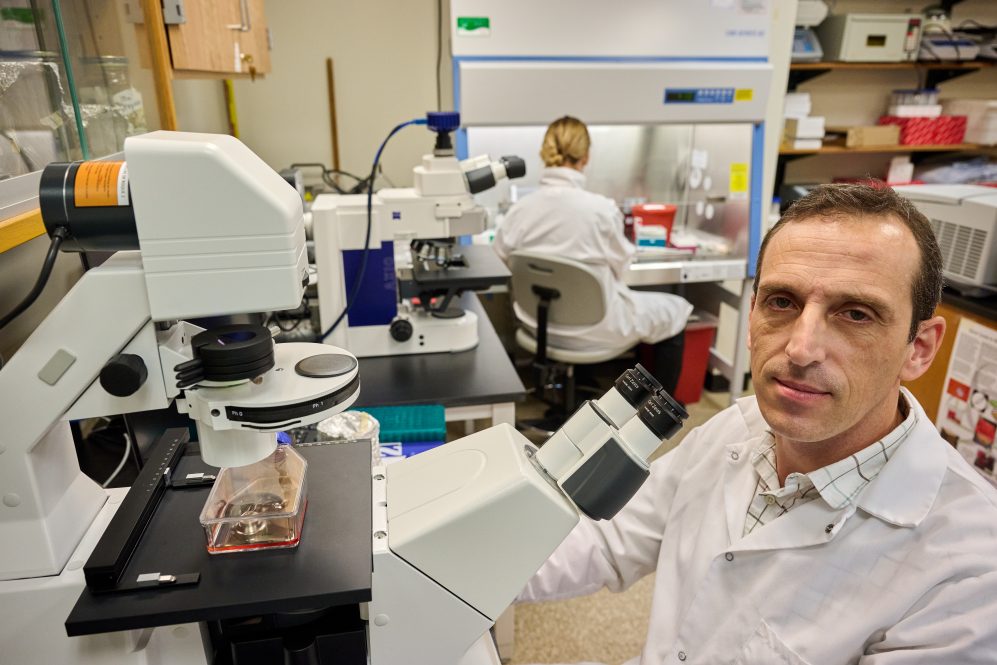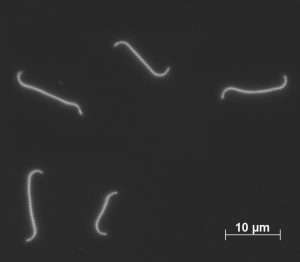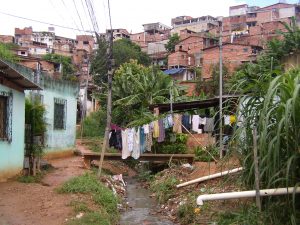'We are creating all the perfect conditions for the number of cases to grow'

Elsio Wunder, assistant professor of pathobiology at his lab at the Atwater Laboratory on May 23, 2024. (Peter Morenus/UConn Photo)
Corkscrew-shaped Leptospira and the potentially deadly disease they cause are tricky to study. The bacteria live in the kidneys of animals where they may or may not cause symptoms, and they are readily released into the environment whenever their host urinates. Though the bacteria can spread anywhere across the globe, the reason you may have never heard of leptospirosis is that it primarily impacts economically disadvantaged regions like slums in developing countries, although the disease regularly appears in urban areas in the tropics.
Leptospirosis, or lepto, has intrigued Elsio Wunder, an assistant professor in the department of pathobiology and veterinary sciences, for almost 30 years. Wunder is from Brazil where the disease remains a serious issue and is part of a team working to better understand the disease, not only for the benefit of those in countries who regularly deal with outbreaks but also for areas of the world where lepto is a growing threat driven by climate change and increasing inequality. Their findings are published in Neglected Tropical Diseases.
Wunder explains his former mentor started the project which has focused on a specific community in Salvador, Brazil since the late 1990s after the researchers saw numerous cases of lepto clustered in the area.

"It's an interesting disease, and I did my Ph.D. in Brazil where the research for this paper was done," Wunder says. "The project is very multidisciplinary because we have nurses, doctors, veterinarians, geographers, and the community members that we follow every six or 12 months."
The researchers collect blood samples from members of the community, conduct interviews, and gather geolocational data on houses and features of the neighborhoods such as topology, the location of open sewers, or where trash is collected. These spatial features help the researchers study aspects that may enhance transmission, like which areas are prone to flooding or where rats are likely to congregate.
This study focused on trying to understand the patterns of infection caused by different types of Leptospira, called serovars. Wunder explains that serovars add a layer of complexity to studying this disease because each serovar has varying preferences for which animals can act as reservoirs, or if and how it causes symptoms in the animal.
"In the community where I work in Brazil, the interesting feature is that since the rat is the main reservoir, the main serovar circulating in that city is called Copenhageni. We saw that serovar in the rats, we saw in humans, and we saw in the environment and that's unique because most of the time you have a lot of serovars circulating because you have a lot of animals and other sources of contamination."
However, after over two decades of tracking, Wunder says they began to see a new serovar circulating, Cynopteri, and they want to know if new or different risk factors drive these infections.
Knowing these factors is important because there is currently no vaccine available for humans, and the vaccines available for animals are generally not efficient because, although they protect against disease and death, they do not protect against the spread of the disease.
Working to understand risk factors
Therefore, the best way to prevent disease is by tackling other aspects of transmission, which for Leptospira means taking measures to improve sanitary conditions and knowing which animals contribute to the spread. To do this most efficiently, research like Wunder's is needed to understand the risk factors that drive the spread of different serovars.
The analysis showed increases in both serovars with increasing age in study participants, but the seropositivity differed between the serotypes. For Cynopteri, the researchers saw increases in seropositivity in people living in houses with unplastered walls and in households with cats nearby. For Copenhageni, seropositivity was higher in men, in those who had contact with sewage, and via work-related exposure. Though the researchers are not sure about the causes of the different epidemiological patterns, cats could play a role.
In epidemiology, confounding factors influence disease transmission indirectly. In the case of cats, there is no evidence they get sick or are responsible for the spread of lepto but they seem to have some influence. Wunder explains another example of a confounding factor from one of his previous studies where they found that chickens living within the household served as a confounding factor.
"Just like cats, chickens don't get lepto and they don't transmit it but we learned that usually in communities where people have chickens, they throw food scraps to the chickens to eat, and that creates a source of food for rats," he says.
If Cynopteri rates are higher in areas where there are cats and therefore it is not spread by rats, how is it spreading?
"One hypothesis is that as predators of rats, having cats reduces the chances of having rats around your house. This might allow other serovars which are not necessarily transmitted by rats to take over and then you see more positivity in people because of other serovars from other sources that, unfortunately, we don't know yet. That's something that we need to figure out."
Outbreaks can appear outside the tropics
Details like these are important to figure out to understand outbreaks in other regions, including areas of the United States, such as Puerto Rico, Hawaii, and Florida experiencing cases. Even temperate regions like Illinois and New York can see outbreaks in warmer months.
"In Illinois at the end of the 1990s, there was a big outbreak where people doing triathlon and swimming in a lake got infected."
Wunder explains warming climates aid lepto's environmental spread and coupled with socioeconomic factors like growing inequality and poverty that further aid transmission, rates of the disease are on the rise.
"For me, coming from Brazil, this is a very common trend. I have seen the social inequality and I know what people in slum communities live with. I think people in the U.S. are not used to that, but conditions of social and economic inequality are increasing here too. Of course, together with climate change, we are creating all the perfect conditions for the number of lepto cases to grow."

Wunder says that until recently, the annual average number of cases of lepto in New York City held steady at around three to four cases, with most of those instances from people returning from tropical locations. This began to change in 2021, when Wunder says there were 15 cases, and only one was travel-related while the rest were spread within the community, likely due to rats. All 15 were acute infections and required hospitalization and the outbreak resulted in one death.
"A recent report showed that in 2023 they had 24 cases and this year, as of mid-April, we have already had six cases in the city. So even in New York City, you see increasing cases," Wunder says. "Of course, we are only talking about 20 cases and if you compare it to other diseases, that sounds like something that is not that relevant, but for diseases related to poverty or developing countries, when you see those numbers in developed countries, then you should start getting more concerned."
Sanitation is key, but implementing change requires investment in infrastructure which governments are not always willing to undertake. In Brazil, the authors note that nearly 30% of the population lives in urban, poor communities. In the community where the study was conducted, there are open sewers, meaning people encounter sewage on their way to work, school, or any time the area floods. Wunder says when he teaches classes on water, sanitation, and hygiene, this fact of daily life for so many and the lack of will to change those conditions is a wake-up call for students.
"It's such a no-brainer that having an open sewer cannot be sanitary, but one of the things that we learn throughout the class is that every time you talk about investment in water, sanitation, and hygiene, the stakeholders always ask for evidence and they want to know the cost-benefit of investing billions of dollars in these communities," he says. "Always, one of the complaints is there is no strong evidence. It's very hard to look in the eyes of your students in the 2020s and explain we still have to prove that closing sewers is a good thing. It just blows my mind."
A ticking time bomb
Wunder says it is important that people realize that poverty increases the chances of diseases like lepto spreading and that these are the realities for populations around the world. Besides providing more evidence to present to stakeholders, Wunder says this research is important for helping to educate people, including members of the communities most at risk.
"This research helps to give tools to the people who live and work in those areas to educate them on how to avoid the disease," he says. "When I do my presentations, I always have a picture from a house near an open sewer where there's a brown line about a foot and a half off the ground and I point out to show where the water reaches when it rains and it floods. How do you educate people to not go into the flood when they have to go to work or school? This information gives us the necessary tools to try to do our best and prevent people from getting this disease, which has high levels of lethality if not diagnosed or treated well."
The number of people living in slums is expected to continue to rise, coupled with a growing global refugee crisis, all in addition to climate change and increasing inequality creates a situation where Wunder says leptospirosis is a ticking time bomb that needs more attention.
"That is part of neglected diseases, this idea that because we are in a developed country, we're immune to those things, but we are not," Wunder says. "Those things are happening in this country and in Europe because the situations are changing."






